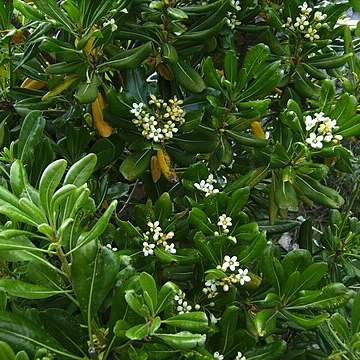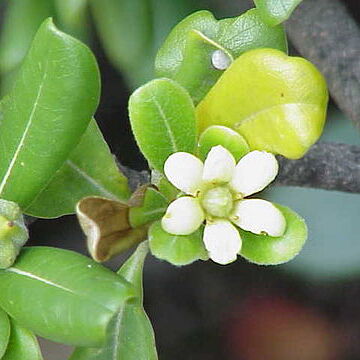Evergreen, erect, aromatic, shrubs or trees, sometimes epiphytic. Growth in flushes, terminal bud protected by cataphylls (and/or bud scales?). Leaves ex-stipulate, spirally arranged, often crowded in pseudo-whorls, specially towards the ends of the twigs, petioled or seldom sessile, entire (often sinuate in 7. P. sinuatum), generally more or less acuminate, penninerved, young leaves often pubescent. Inflorescences terminal or axillary, in some spp. mainly ramiflorous, few to many-flowered, in fascicles, thyrsoid, or in more or less condensed racemes, rarely solitary, essentially cymose. Flowers bisexual or functionally unisexual apparently to various degree, generally white or pale yellow, except in 5. P. berberidoides, fragrant. Sepals 5, free or connate to various degree. Petals 5, generally ligulate, free or coherent in the lower part, free segments spreading or recurved. Stamens 5, free or occasionally coherent with the corolla tube; filaments in more ♂ flowers slender, in more ♀ flowers somewhat shorter and slightly broadened at the base; anthers dorsifix, introrse, in more ♂ flowers generally oblong, in more ♀ flowers sagittate, and smaller. Pistil sessile or stipitate, stipe thick, 5-furrowed, generally passing into the ellipsoid ovary; ovary glabrous or pubescent, 1-celled, in more ♀ flowers slender or cuneiform, in more ♂ flowers plumper and thicker; placentas 2(-5), (in one case 6!), parietal or basal, with a varying number of ovules; style glabrous, in more ♀ flowers somewhat longer than in more female flowers; stigma in more ♂ flowers hardly thickened, in more female flowers capitate, 2-5-lobed. Capsule globose, ellipsoid or ovoid, 1-celled, loculicidally lengthwise 2(-5)-valved, in Mal. spp. glabrous, mostly orange when mature, often mucronate by the remains of the style; valves of varying thickness, woody or coriaceous, occasionally with resini-ferous cavities, chambers of ducts, inside generally transversely ribbed or pinnately striated; funicles along the median longitudinal placenta or basal. Seeds 1-∞, generally compressed against each other and irregularly angular and wrinkled, variably in size and shape, reddish or blackish, coated by a resinous, viscid fluid. Endosperm horny, large; embryo minute; cotyledons 2-5; germination epigeous.
Trees, shrubs, or sometimes subshrubs, evergreen, pubescent or glabrous. Leavs alternate, appearing opposite or pseudoverticillate, usually clustered at branchlet apex; leaf blade leathery or sometimes membranous, margin entire, undulate-dentate, or rugose. Inflorescences terminal or axillary, umbellate, corymbose, paniculate, or a solitary flower. Flowers bisexual, rarely polygamous. Sepals 5, free, usually short and small. Petals 5, free or partly connate. Stamens 5; filament glabrous; anther dorsifixed, ± sagittate, longitudinally dehiscent. Ovary superior, usually stipitate, of 2 or 3(–5)carpels, 1-loculed or incompletely 2–5-loculed, pubescent or glabrous; ovules usually numerous, sometimes 1–4; placentas parietal and equal in number to carpels, or basilar owing to reduction of ovules. Style short, simple or 2–5-lobed, usually persistent. Capsule ellipsoid or globose, sometimes compressed, dehiscing by 2–5 valves; pericarp woody or leathery, usually with horizontal striae adaxially. Seeds usually surrounded by glutinous or greasy material.
Trees or shrubs, never climbing or spiny. Leaves entire or (outside Africa) rarely undulate or sinuate, glabrous or hairy. Inflorescences usually many-flowered subracemose or subumbellate panicles, terminal and/or axillary from the uppermost leaves, but (outside Africa) flowers sometimes solitary or clustered on the old wood. Flowers regular, up to 15 mm. long, of various colours (but only white, greenish or yellow in Africa), sweet-scented, very often, perhaps always, functionally unisexual; ♂ with long filaments, fertile anthers and slender sterile ovary; ♀ with short filaments, reduced sterile anthers and stout fertile ovary. Ovary unilocular, 2(–5)-merous; style ± as long as ovary, with truncate or sublobed stigma, splitting in fruit according to number of carpels; ovules ovoid. Fruit a capsule; valves leathery or woody, yellow or brown, finally suberect, spreading or reflexed. Seeds variously deformed by mutual pressure, 2–4(–many outside Africa) in two rows on each placenta, ripening orange or red, covered with a sticky slow-drying resin.
Fls perfect to unisexual by abortion, panicled to umbellately arranged or in fascicles, or solitary. Ovary 2-5-celled, style short; ovules few to ∞, sts aborted. Fr. a globose to ovoid or obovoid capsule with solitary to ∞ seeds; valves 2-5, us. woody or leathery, crowned by hardened remains of style; seeds often immersed in viscid fluid. Trees and shrubs with alt. to subverticillate lvs. Genus of some 160 spp., mainly tropical and subtropical southern hemisphere; the N.Z. spp endemic.
Flowers actinomorphic, never more than 15 mm. long, of various colours (in our area only white, yellowish or greenish) sweet-scented, functionally unisexual; male with long filaments, fertile anthers and slender sterile ovary; female with short filaments, reduced sterile anthers and stout fertile ovary.
Ovary 1-locular, with 2–5 (in our area always 2) carpels; style short with a capitate or 2-lobed stigma, splitting in fruit according to the number of carpels; ovules ovoid.
Inflorescences usually variously paniculate or subracemose, terminal or terminal with axillary branches, rarely fascicled, or flowers solitary and axillary.
Seeds variously deformed by mutual pressure, 2-many in 2 rows on each parietal placenta, orange to red, covered with a sticky, slow-drying resin.
Fruit capsular with entire, leathery or woody, erect or spreading valves, sometimes reflexed when quite ripe.
Leaves usually entire, sometimes undulate, rarely subserrate or shallowly lobed, glabrous or pilose.
Petals with claws sometimes connivent and blades usually spreading or revolute.
Usually all the flowers of one inflorescence alike (? monoecious or dioecious).
Sepals free or ± connate, imbricate or not.
Trees or shrubs, never climbing or spiny.
Anthers opening by slits.


